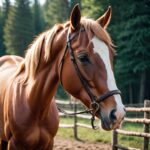The Essential Guide to Horse Feed: Nutrition, Types, and Best Practices
Horses, like humans, require a balanced diet to maintain optimal health and performance. Whether your horse is a high-performance athlete, a leisurely companion, or anything in between, understanding the basics of horse feed is crucial for ensuring their well-being. This article delves into the essentials of horse nutrition, the types of feeds available, and best practices for feeding your horse.
Understanding Horse Nutrition
Horses are herbivores with a digestive system uniquely designed to process fibrous plant material. Their diet should be centered around forage, primarily grass or hay, which provides the necessary fiber for their gut health. However, depending on their activity level, age, and health status, horses may require additional nutrients that forage alone might not supply.
Key Nutritional Components:
- Forage (Fiber): The cornerstone of a horse’s diet, forage should constitute at least 50% of their daily intake by weight. It aids in digestion, maintains gut health, and provides necessary calories.
- Carbohydrates: These are the primary energy source for horses. Carbohydrates come from two sources:
- Simple Carbohydrates: Found in grains like oats, barley, and corn, these are quickly absorbed and provide rapid energy.
- Complex Carbohydrates: Found in hay and grass, these are slowly digested, offering sustained energy over time.
- Protein: Essential for muscle development and repair, protein needs vary depending on the horse’s age, workload, and reproductive status. High-protein feeds are typically given to growing foals, lactating mares, and performance horses.
- Fats: A concentrated energy source, fats are included in horse feeds to boost calorie intake without increasing the amount of grain. They are especially useful for horses needing more energy or those prone to digestive issues with high-grain diets.
- Vitamins and Minerals: Horses require a range of vitamins (like A, D, E, and K) and minerals (such as calcium, phosphorus, and magnesium) for various bodily functions, including bone health, immune function, and muscle activity. These are usually obtained through a combination of forage, grains, and supplements.
- Water: Often overlooked but critical, horses need access to clean, fresh water at all times. Dehydration can lead to colic, reduced feed intake, and overall poor health.
Types of Horse Feed
Horse feed can be categorized into several types, each serving different nutritional purposes based on the horse’s needs.
1. Forage (Hay and Pasture)
- Grass Hay: Includes timothy, Bermuda, and orchard grass. It’s lower in protein and energy but high in fiber.
- Legume Hay: Alfalfa and clover fall into this category, offering higher protein and calcium levels, making them suitable for horses with higher nutritional demands.
- Pasture: Fresh grass provides excellent nutrition but can vary widely in nutrient content depending on the season, type of grass, and soil quality.
2. Concentrates (Grains and Pellets)
- Oats: A popular grain, easy to digest, and provides a good balance of energy and fiber.
- Barley: Higher in energy than oats but lower in fiber, making it a good choice for horses needing extra calories.
- Corn: Highly energy-dense, corn is used in small amounts to increase calorie intake but must be fed carefully due to its low fiber content.
- Pelleted and Extruded Feeds: These are processed feeds that combine grains, fiber, and added vitamins and minerals. They offer a balanced diet in convenient form and can be tailored to specific needs, such as senior horses or those with metabolic issues.
3. Complete Feeds
- Designed to provide all the necessary nutrients in one package, complete feeds are ideal for horses that cannot consume enough forage or have specific dietary requirements. They are typically high in fiber, making them suitable as a sole ration.
4. Supplements
- Vitamin and Mineral Supplements: Used to balance a horse’s diet when forage and concentrates don’t provide adequate levels.
- Electrolytes: Important for performance horses, especially in hot weather, to replace salts lost through sweat.
- Probiotics and Prebiotics: These support digestive health, particularly in horses prone to gastrointestinal issues.
Best Practices for Feeding Horses
Feeding horses is more than just providing food; it requires careful consideration of their unique needs and habits.
1. Feed Consistently: Horses thrive on routine. Feed them at the same times each day to maintain digestive health and reduce stress.
2. Measure Feed Accurately: Overfeeding can lead to obesity and related health issues, while underfeeding can cause malnutrition. Use a scale to measure feed rather than relying on volume, as different feeds have different densities.
3. Adjust for Workload: Increase the energy content of the diet as a horse’s workload increases, and reduce it during periods of rest or lighter work.
4. Monitor Body Condition: Regularly assess your horse’s body condition score (BCS) to ensure they are neither underweight nor overweight. Adjust the feed accordingly to maintain an ideal BCS.
5. Provide Free-Choice Forage: Whenever possible, allow horses access to forage throughout the day to mimic their natural grazing behavior and promote healthy digestion.
6. Ensure Access to Clean Water: Horses should always have access to fresh, clean water. In colder climates, ensure water is not frozen, and in hot climates, monitor water intake closely.
7. Introduce Changes Gradually: If you need to change your horse’s feed, do so gradually over 7-10 days to prevent digestive upset.
Conclusion
Proper nutrition is the foundation of a healthy, happy horse. Understanding the basics of horse feed, from the essential nutrients to the types of feed available, empowers you to make informed decisions about your horse’s diet. By following best practices in feeding, you can ensure your horse remains in peak condition, ready to perform at their best, whether in the show ring, on the trail, or simply as a beloved companion.


